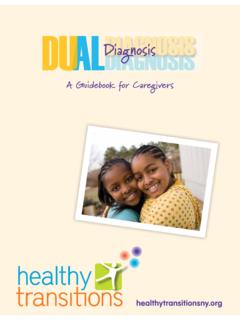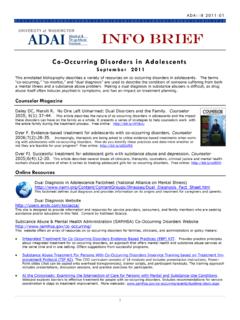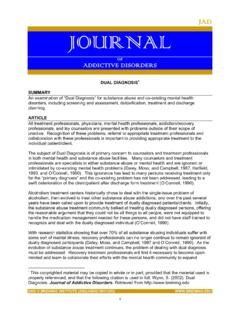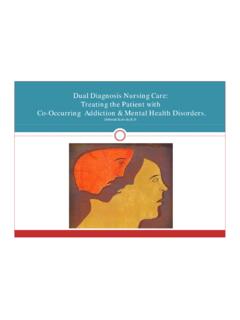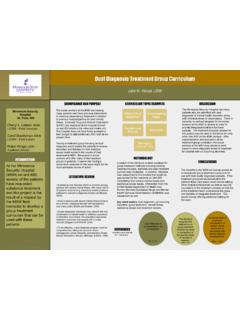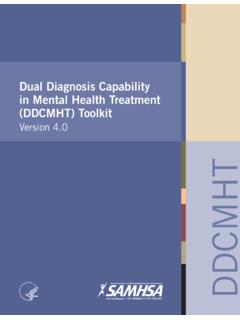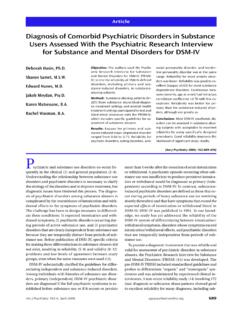Transcription of Dual Diagnosis Capability: Moving from Concept to ...
1 BEST PRACTICESDual Diagnosis Capability: Moving from Concept to ImplementationKenneth Minkoff, MDChristie A. Cline, MD, MBAWhat is dual Diagnosis capability (DDC)?As mental health andsubstance abuse treatment programs are increasingly recognizing thatthey are serving more complex populations, commonly with co-occur-ring disorders, they face the following question: Within the context ofscarce resources, how do they provide services in a manner that is con-sistent with their existing mission and program design, but that also rec-ognizes, accommodates, and incorporates attention to the increasinglycomplex needs of their service population? The answer to this questionis embodied in the Concept of dual Diagnosis capability (DDC), andwhile this Concept is by no means universally understood, the meaningof DDC is becoming clearer through the work of hundreds of agenciesand programs throughout the United States and Canada involved in theDDC development evolving Concept of dual Diagnosis capability refers to the notionthat every agency/program providing behavioral health services mustKenneth Minkoff, MD (E-mail: A.)
2 Cline (E-mail: of dual Diagnosis , Vol. 2(2) 2006 Available online at 2006 by The Haworth Press, Inc. All rights a core capacity, defined through specific components of programinfrastructure like policies, procedures, clinical practice instructionsand standards, and clinician competencies and scopes of practice, toprovide appropriate services to the individuals and families with co-oc-curring mental health and substance use issues who are already comingthrough its is in contrast to dual Diagnosis Enhancement (DDE). DDC refersto an evolving core capacity of all programs, while DDE programs arespecialized mental health and/or substance abuse programs and servicesdesigned to provide more integrated programming for clients with co-occurring disorders with more specialized needs. Examples of DDE pro-grams may include a dual Diagnosis Psychiatric Inpatient Unit with anextensive array of addiction programming in a psychiatric acute care set-ting; an evidence based Integrated dual Disorder Treatment (IDDT) teamfor adults with Serious and persistent mental illness and severe co-occur-ring disorders requiring high intensity case management and outreach; oran addiction residential program with higher levels of staffing and mentalhealth specialization to provide addiction treatment to individuals withmore acute or disabling psychiatric conditions.)
3 For reasons that will beclarified below, it is becoming clearer that while systems must have ade-quate capacity to provide specialized services to targeted populations, thecapacity of a system to organize DDC throughout as a base standard iscritical to strengthening the efficiency and efficacy of service delivery tothe behavioral health population as a history and characteristics of DDC will be described in moredetail in this column. This column then presents an illustration of usualstarting places for the implementation of DDC within agencies/programs engaged in a developmental process. It then ends with consid-eration of future challenges as DDC becomes better defined and organ-ized throughout system of with co-occurring disorders are increasingly recognizedas a population with poorer outcomes and higher costs in multipledomains, with sufficiently high prevalence in all treatment and humanservice systems that the Substance Abuse and Mental Health ServicesAdministration (SAMHSA) Report to Congress has acknowledged that dual Diagnosis is an expectation, rather than an exception in all set-tings (SAMHSA, 2002).
4 Further, two decades of research with a wide122 JOURNAL OF dual Diagnosis variety of populations, from adults with serious and persistent mentalillness, to adolescents and families involved with the court system(either criminal justice or child protection) have provided increasingsupport for the increased efficacy of integrated treatment programsand interventions, in which appropriately matched strategies for bothmental health and substance abuse issues are combined, coordinated, orintegrated into the context of a single treatment relationship, treatmentteam, or treatment setting. Specific program models, ranging from Inte-grated dual Disorders Treatment (IDDT) (Drake et al., 2001) (one ofthe six SAMHSA evidence based practice toolkits for adults with seri-ous and persistent mental illness), modified therapeutic communities(Sacks et al., 1999) (applied most extensively to adults with all levels ofseverity of mental illness who are in correctional settings), and multi-systemic family therapy (ref) (applied to adolescents with multisystemproblems) have emerged from the research, and begun to be imple-mented as specialized ( dual Diagnosis Enhanced, or DDE) dualdiagnosis or co-occurring disorder programs in real world , although these (and other) specialized programs have oftenhad demonstrated success with the selected populations they have beenable to treat, it has become increasingly apparent that because peoplewith co-occurring disorders are an expectation in ALL programs, set-ting up a few specialized (and expensive)
5 Programs in systems withscarce resources only has a limited impact on the ability of the system asa whole to address the large, complex, and pervasive populations of in-dividuals and families with co-occurring disorders. Thus, because dualdiagnosis is an expectation, it has been more widely recognized thatALL programs are essentially becoming dual Diagnosis programs(whether or not that was part of their original design) and require an in-frastructure and operational procedures regarding the provision of ap-propriately matched services to their existing cohorts of dual diagnosisclients and families. (This is in marked contrast to the functioning of themany current disjointed systems of mental health and substance abusetreatment, in which mental health programs and substance abuseprograms have almost NO design or instructions for how to provide ap-propriate services to their existing cohorts of co-occurring clients andfamilies.)
6 This recognition has become the foundation for defining theconcept of dual Diagnosis capability as a core feature of any , research strategies have begun to evolve beyond thecreation of special programs, to explore a wide range of specific inter-vention strategies that have been demonstrated to be successful inspecialized settings, and to define how those same strategies might beBest Practices123of value in the other settings. Recent summaries of the best practiceliterature ( , Treatment Improvement Protocol #42 (CSAT, 2005),and Mueser et al. s textbook on integrated dual disorders treatment(Mueser et al., 2003)) support the dissemination of this knowledgebase to a wider array of clinicians and programs, and begin to createmore capacity to apply evidence supported intervention strategies inall types of clinical programs and clinical settings. These interventionstrategies range from empathic, hopeful, integrated relationships tobest practice methods for integrated screening and assessment, to inte-grated instructions for the application of various interventions for eachtype of disorder.
7 , psychopharmacology, case management matchedto level of disability, stage-specific motivational strategies, cognitivebehavioral skill building adapted to level of impairment, peer and fam-ily education and support, contingency management, and rehabilita-tive strategies to promote vocational, social, and housing outcomes,This emerging awareness of treatment intervention strategies that canbe generally, and cost effectively, applied in all settings has supportedthe evolution of the Concept of dual Diagnosis capability in real sys-tem OF dual Diagnosis CAPABILITYIn 1991, Minkoff first described a model for system design, termedthe Comprehensive Continuous Integrated System of Care, in whichthere was acknowledgment that all programs in either the mental healthand substance abuse systems were already likely to be serving a rangeof populations with co-occurring disorders, and therefore needed to be-gin to develop appropriate approaches to these existing populationswithin the context of standard treatment.
8 This initial conceptualizationwas further defined in a consensus panel report developed as part of theSAMHSA Managed Care Initiative, entitled: Co-occurring Psychiatricand Substance Disorders in Managed Care Systems: Standards of Care,Practice Guidelines, Workforce Competencies, and Training Curricula (1998). This was the first report in which the recommendation for sys-tem design for any population incorporated the development of specificprogram standards for each type of program in the system, and in whichsome of the specific jobs of each type of program were briefly de-scribed. In the same year, NASMHPD and NASADAD (the NationalAssociations of State Mental Health Program Directors and Alcohol124 JOURNAL OF dual DIAGNOSISand Drug Abuse Directors, respectively) agreed on a national consensusfour quadrant model for describing the system distribution and respon-sibility for individuals with co-occurring disorders, implying that dif-ferent systems and programs might have distinct responsibilities withexisting clients, reflecting the different characteristics of the quadrants( , Quadrant 2 High MH, Low SA-were to be treated in the MH sys-tem; Quadrant 3 High SA, Low MH-in the SA system) (NASMHPD/NASADAD, 1998).
9 The terms dual Diagnosis capability and dual Diagnosis Enhancedgrew from the Managed Care Initiative 1998 report, and emerged firstin the national literature with the release of the American Society of Ad-diction Medicine Patient Placement Criteria, Second Edition, Revised(Mee-Lee et al., 2001) which described DDC as a recommended corefeature of any addiction program at any level of care, reflecting the factthat standard addiction services needed to be capable of appropriatelyserving a growing population of individuals represented in Quadrant 3with mild to moderate Axis I and Axis II disorders co-occurring withtheir substance dependence. ASAM PPC 2R asserted that while therewere addiction programs that would remain Addiction Only (AOS)(with little or no organized capacity to meet the needs of co-occurringclients), the need for these types of programs would be likely to narrowover time, due to the increasing pressure and volume of co-occurringclients needing services.
10 The definitions of DDC and DDE in ASAMPPC 2R were quite general, however, and fell short of providing addic-tion programs with specific instructions for what these concepts wouldmean in practice. The following is the definition of DDC, and a partialdescription of DDE, from ASAM PPC 2R:Throughout the adult criteria in the PPC-2R (addiction) treatmentprograms are described as generally of two types dual DiagnosisCapable or dual Diagnosis Enhanced to reflect their ability to addressco-occurring substance-related and mental disorders. dual Diagnosis Capable programs have a primary focus on thetreatment of substance-related disorders, but also are capable oftreating patients who have relatively stable diagnostic or sub-dia-gnostic co-occurring mental health problems related to an emo-tional, behavioral, or cognitive disorder. dual Diagnosis Enhanced programs, by contrast, are designed totreat patients who have more unstable or disabling co-occurringmental disorders in addition to their substance-related Practices125 dual Diagnosis Capable ProgramsThese programs typically meet the needs of patients whose psychiatricdisorders are stable and who are capable of independent functioning,so that their mental disorders do not interfere significantly with theirparticipation in addiction treatment.
